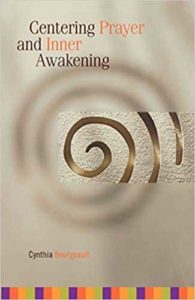Last month we held our first small Wisdom Book Practice Circle gatherings to engage with Part I of “Centering Prayer and Inner Awakening,” as well as our Wisdom Practice Day on August 28. The Practice Day was gratifying to all those engaged with the Wisdom work as it drew so many to our collective. The day was deep, embodied, and sent powerful energy into the cosmos. So many participants felt connected and whole, and in that there is healing for the planet.
 Our small Wisdom Book Practice Circles were also a deepening and an opening to our Christian calling to self-emptying and self-opening leading to a great love expressed in our relationships with God and our human family.
Our small Wisdom Book Practice Circles were also a deepening and an opening to our Christian calling to self-emptying and self-opening leading to a great love expressed in our relationships with God and our human family.
This coming month we will be working with Part II in Cynthia Bourgeault’s Book Centering Prayer and Inner Awakening, entitled: The Tradition of Centering Prayer, Chapters 6, 7 and 8.
The method of Centering Prayer as taught to a spiritual student in the 14th century by the anonymous author of the Cloud of Unknowing, was an invitation to keep the longing for the love of God close to heart with simplicity of expression and eloquent desire. It was also taught as the way to keep one’s whole being and consciousness centered and attentive to our divine nature. The author of the Cloud was not giving a method to practice for 20 minutes twice a day. Rather, the intention is to keep consent to the divine always before us, in all of our activity. As monastics have recognized for centuries, through the practice of Lectio Divina, the way to do that is to acknowledge the mind’s thoughts, allow them, and finally to move beyond those thoughts and whatever imaginings and ideas they want to hold.
It’s as if the thoughts are moved from the mind into a more spacious place where they are present but not dominating us. We sense that we are grounded in our Source and that all of our fellow beings are there, also manifesting from the same Source. We cannot help but love them “As Our Self.” This sensation is not a thought and cannot even be held by the limits of the mind. It can however, be paid attention to as if floating on the sea, we are held and suspended in an energetic field, a field of love.
If we open ourselves to a continual path of growth in the practice of Centering Prayer, we find that there is no stopping place, no fixed boundary to our practice. We know that the steady and persistent practice of Centering Prayer twice daily fortifies us and keeps the muscle tone of letting go and opening.
 Our intention and consent continue as we rise from our meditation cushion. We are motivated by love and desire to keep centered as we are immersed in all of our daily work and activity. Our center is where we find our wholeness and our connection to the human family.
Our intention and consent continue as we rise from our meditation cushion. We are motivated by love and desire to keep centered as we are immersed in all of our daily work and activity. Our center is where we find our wholeness and our connection to the human family.
We do this through practice that allows us to pay attention interiorly while working externally with others. This does not come without effort and work, and such attention relies on the energetic field we establish in meditation. We do this through intentional practice, similar to the Welcoming practice. In the Wisdom Work this practice is also known as conscious work performed with inner tasks. Inner tasks come from the teachings of G.I. Gurdjieff and have become an important part of our Wisdom lineage. Inner tasks are essentially about supporting our work with waking up to our automatic patterns and becoming present in the conditions of our lives as they are. They begin with the foundational work of self-observation. Self-observation is something that only we can do for ourselves and brings with it self-knowledge that allows us to continually consent to our greater Being. See below for our INNER TASK for this month.
Lastly, I want to express my desire to reconcile the Christianity I knew as a child and young man with what I have come to know as Truth in my years of contemplative work. Beyond the doctrine and ritual observance, I learned early that love is or should be infused in all of our lives as a Christian practice. The knowledge we acquire through inner somatic awareness is reliable and love is the work of relationship not controlled by the mind.
In chapter 8 of CPIA, Cynthia makes a stunning assertion of the essential eloquence of being a follower of Jesus. She says,
“There is another route to the center, however: a more reckless and extravagant path, which is not through storing up the energy, but through throwing it all away – or giving it all away. The unitive point is approached not through the concentration of being, but through the free squandering of it. This paradigm, which I like to think of as the “throw-it-away” school, works on the principle that the energy of being is infinite and flows to us from an unstinting Source if we can merely allow this flow to happen. In Christianity, this understanding is expressed through the path of kenosis.
Self-emptying is also, in the deepest sense, self-disclosure, a fundamentally creative act. New worlds can come into existence by revealing what had formerly been present only in potential….. It is also, clearly, how Christ redeemed it – storing up nothing, clinging to nothing, equally at home in humiliation and glory. His ultimate act of self-emptying on the cross is what brings into being the New Creation – i.e., the Kingdom of Heaven made fully manifest.
As Paul so profoundly realized, “up” and “down” do not ultimately matter, for in kenosis consciousness reclaims dominion over energy. The pathway to freedom, to the realized unity of our being, lies in and in fact is coextensive with the sacramental act of giving it all away, making “self-giving” the core gesture through which all meaning, purpose, and nobility of our human life is ultimately conveyed.
Centering Prayer – of all the methods of meditation, it most purely approximates meditational kenosis. It is pure self-emptying.
In Centering Prayer, one aims to attain nothing; not clear mind, steady-state consciousness, or unitive seeing. It is a prayer that simply exercises the kenotic path; love made full in the act of giving itself away” (excerpts from p. 85 – 88).
Some additional quotes for consideration:
“Our soul must perform two duties. The one is we must reverently wonder and be surprised; the other is we must gently let go and let be always taking pleasure in God.” by Julian of Norwich. (quoted from Christian Mystics by Matthew Fox, #49).
“Love your God with all your heart, and all your soul, and all your mind. The second is like it: Love your neighbor as yourself.” (Mt 22:36-40)
When I take in the literal words, allow them to sit within me, then open to their reality, I experience only one task described by Julian and only one commandment spoken by Jesus, Love.
~ Peace and Great Love. Alan
To read more about Alan Krema, click here: /resources/alan-krema/
Inner Task #2 by Elizabeth Combs
(Inner tasks come from the teachings of G.I. Gurdjieff and have become an important part of our wisdom lineage. Inner tasks are essentially about supporting our work with waking up to our automatic patterns and becoming present in the conditions of our lives as they are.)
Cynthia writes that “Word and silence form a sort of breathing which is at the heart of the Christian path of inner awakening” (p 67). Breathing has a natural rhythm of give and take. While we live, we are constantly filling our lungs with oxygen and emptying them of carbon dioxide. We can only hold an inhale for so long before we need to exhale, and the converse is also true. Practicing with our breath gives an immediacy to our understanding of storing up and letting go.
While many methods of meditation focus on storing, concentrating and attaining, Centering Prayer aims to attain nothing, only the exercise of the heart-centered kenotic act — “love made full in the act of giving itself away” (p 88). The gesture of self-emptying itself provides its meaning and its significance. As we practice this gesture again and again in a Centering Prayer session, we may come to know that we are held and carried by a wholeness, something other than our own self-will.
What does this have to do with our breath? Aren’t exhales just expelling what our bodies no longer need? Consider that we humans (and all mammals) inhale oxygen, which is what trees no longer need. And we humans (and all mammals) exhale carbon dioxide, the food of trees. So what is no longer useful for one being may be food for another being. Expanding our awareness expands our circle of Oneness.
This month’s exercise brings breath, heart and “I AM” together. Aim to practice this a few times each day. You might want to set an alarm on your phone to remind you to practice.
Take a few moments to relax your body from head to toe.
Then, for another few moments, notice sensation in your feet and flowing up through your body all the way to the top of your head.
Place one palm on the center of your chest, keeping sensation and attention at the center of your chest as you inhale and exhale.
On the inhale, say to yourself “I”.
On the exhale, say to yourself “AM”.
Keep sensation in the area of your heart, the center of your chest, as you breathe.
After a minute or so, let the exercise go.
May this exercise support you in exploring how “Word and silence form a sort of breathing which is at the heart of the Christian path of inner awakening”.
(With gratitude to Claymont friends for the original I AM exercise.)
A Note:
Stay tuned for the next post in the Wisdom Waypoints Centering Prayer and Inner Awakening Circle series! Won’t you join us? Please note that the Book Circle is now full. We encourage individuals and groups of all kinds to take up this study, and follow along with these monthly postings through November 2021, and would love to hear your reflections about this post and the book in the comments below. Thank you!
Our next Wisdom foundational book circle will begin in January 2022 on the book Wisdom Way of Knowing by Cynthia Bourgeault.
(All images are from pixabay)
Centering Prayer and Inner Awakening Book Circle
A monthly series of posts from the friends and leaders of the Northeast Wisdom/Wisdom Waypoints Book Circle Series on: Centering Prayer and Inner Awakening by Cynthia Bourgeault.






